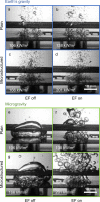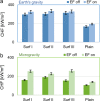Critical heat flux enhancement in microgravity conditions coupling microstructured surfaces and electrostatic field
- PMID: 34625560
- PMCID: PMC8501093
- DOI: 10.1038/s41526-021-00167-3
Critical heat flux enhancement in microgravity conditions coupling microstructured surfaces and electrostatic field
Abstract
We run pool boiling experiments with a dielectric fluid (FC-72) on Earth and on board an ESA parabolic flight aircraft able to cancel the effects of gravity, testing both highly wetting microstructured surfaces and plain surfaces and applying an external electric field that creates gravity-mimicking body forces. Our results reveal that microstructured surfaces, known to enhance the critical heat flux on Earth, are also useful in microgravity. An enhancement of the microgravity critical heat flux on a plain surface can also be obtained using the electric field. However, the best boiling performance is achieved when these techniques are used together. The effects created by microstructured surfaces and electric fields are synergistic. They enhance the critical heat flux in microgravity conditions up to 257 kW/m2, which is even higher than the value measured on Earth on a plain surface (i.e., 168 kW/m2). These results demonstrate the potential of this synergistic approach toward very compact and efficient two-phase heat transfer systems for microgravity applications.
© 2021. The Author(s).
Conflict of interest statement
The authors declare no competing interests.
Figures









References
-
- John H. Lienhard IV & John H. Lienhard V. Heat transfer in boiling and other phase-change configurations. A Heat Transfer Textbook (2010).
-
- Yao Z, Lu YW, Kandlikar SG. Effects of nanowire height on pool boiling performance of water on silicon chips. Int. J. Therm. Sci. 2011;50:2084–2090. doi: 10.1016/j.ijthermalsci.2011.06.009. - DOI
-
- Lee C, Kim H, Ahn HS, Kim MH, Kim J. Micro/nanostructure evolution of zircaloy surface using anodization technique: Application to nuclear fuel cladding modification. Appl. Surf. Sci. 2012;258:8724–8731. doi: 10.1016/j.apsusc.2012.05.081. - DOI
-
- Di Marco P. Review of reduced gravity boiling heat transfer: European Research. Jasma. 2003;20:252–263.
-
- Nukiyama S. The maximum and minimum values of the heat Q transmitted from metal to boiling water under atmospheric pressure. Int. J. Heat. Mass Transf. 1984;27:959–970. doi: 10.1016/0017-9310(84)90112-1. - DOI
Grants and funding
LinkOut - more resources
Full Text Sources

